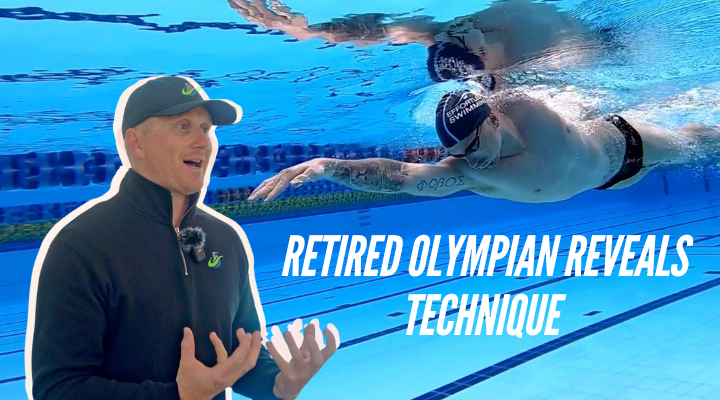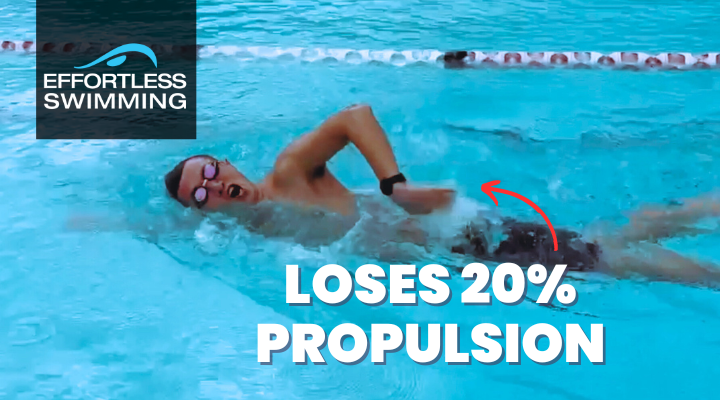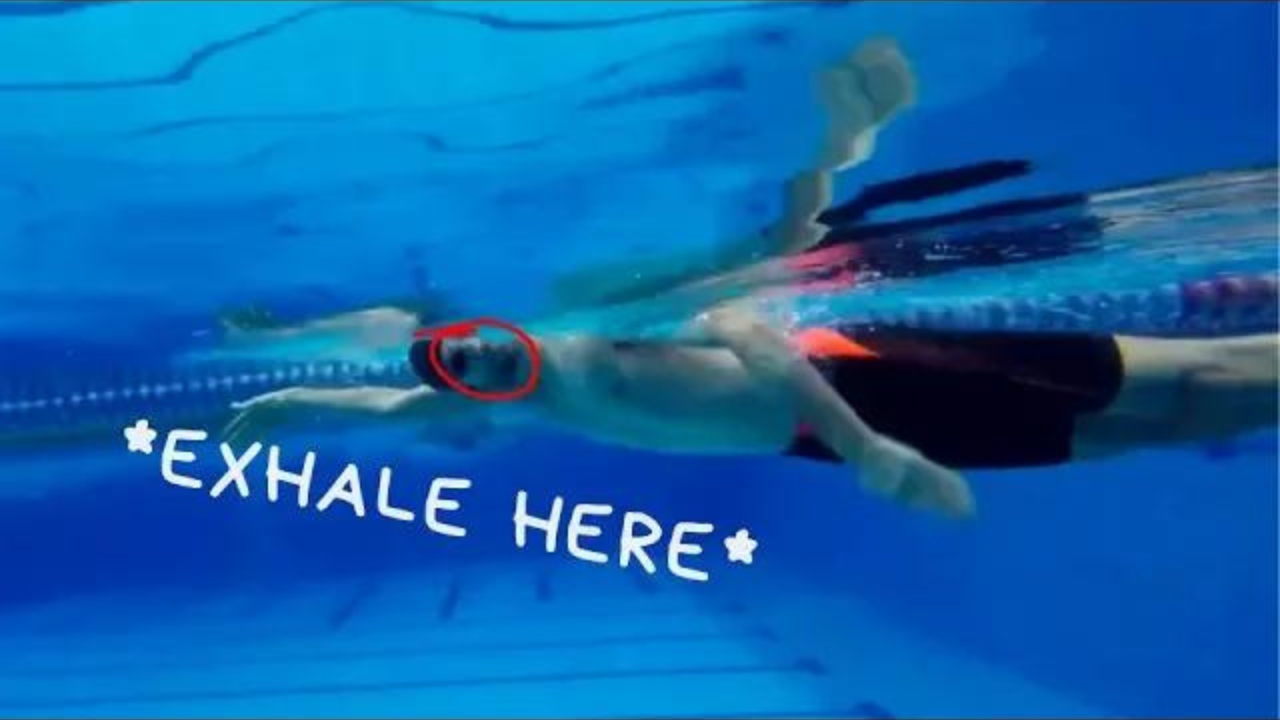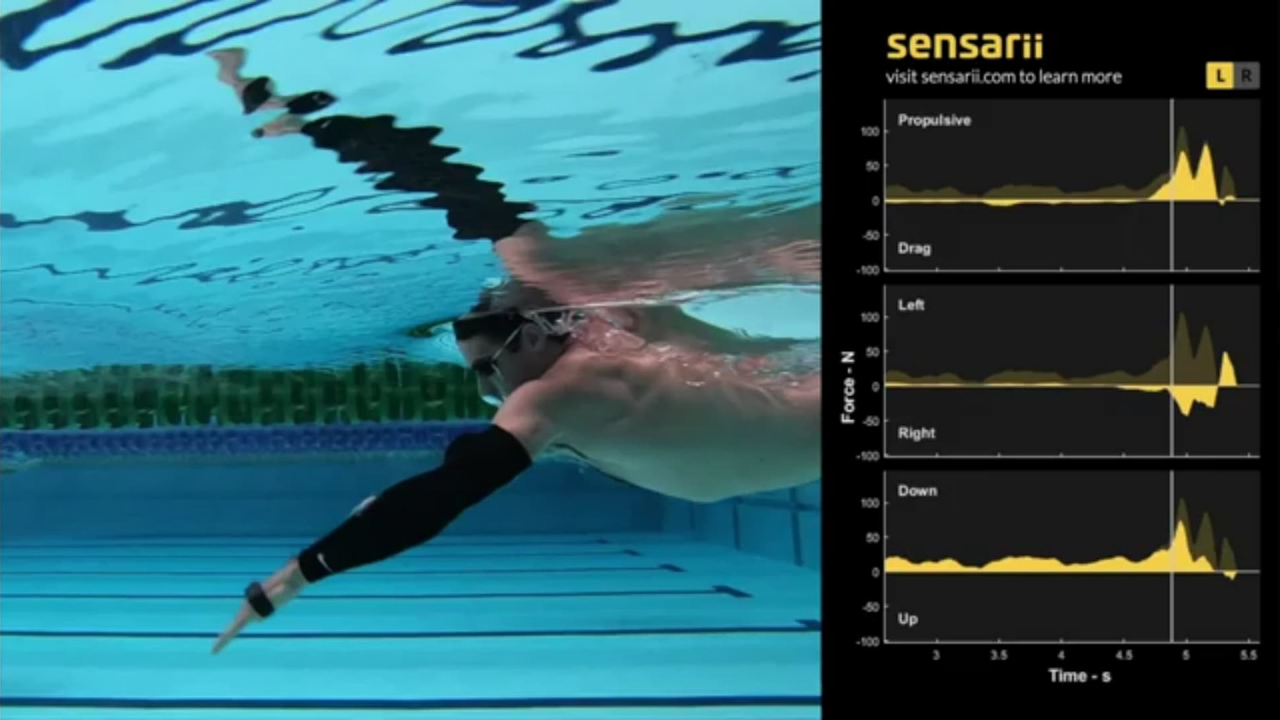We look at swimmer who averages a 1:40/100m pace for his open water swims. His body position is the first we’d look to work on with a change in head position and where and how he enters the water.
Transcription:
In today’s Feedback Friday, we’re looking at a swimmer that’s a little too long at the front of their stroke and needs to lengthen out the back in order to improve their balance and get their head, hips, and heels at the surface.
So in today’s Feedback Friday, we’ve got a swimmer who is around the 1:40 mark for a 1.8 to two and a half K swim. And you can see here that there’s a lot that he’s doing well. The first thing we look at is body position. And we like to look for the head, hips, and heels to be horizontal or at the surface of the water. And you can see that he’s not far away from getting there, but there is that drop through the body. Now, there’s a number of things that can cause that as you know, and head position is usually the first thing that we look for. And you can see the direction of where he’s looking is a long way out in front. We like to stick anywhere from straight down to 45 degrees in front. That’s usually the range you’ll see most swimmers.
Now being an open water swimmer, I’d suggest maybe looking somewhere out here in that upper range, but if you’re as far out as he is, then a few things typically happen. Number one, if you tight through the lower back, and you’re looking that far forward, it’s very hard to keep the back end up near the surface. The other thing with that too is it can often cause you to be very tense through the upper traps there, and it can restrict your ability to get over the water comfortably and also apply the right amount of power through the pull phase of the stroke or the pull and press phase. So we just really want to relax through the back of the shoulders and through the neck a bit more and adjust where he’s looking.
So number one, I would say just look a little bit further down. And the cue that we like to use for this keeps the neck long, so really lengthen out through the neck. Imagine that you’re being pulled up from above. There’s someone here. They’ve got a piece of rope through your head, neck, and spine, and they’re pulling that in front. That’s a really good way to feel like you’re being long through the neck. So that would be the first thing I’d look to do.
As he does it though, just make sure that we don’t want the whole head to go under the water. So we normally like to aim to keep just the top of the head above the surface of the water so just the crown of the head to stay there. Now with the kick, you can see that there’s probably, there’s a little bit of over kicking going on. You can just see how the legs are probably just going a little bit faster than what’s required. But my guess is if he changes his head position and just dials back the kick a bit, just relaxes a little bit more with it, he won’t feel quite as rushed or won’t feel the need to over kick quite as much.
But another thing I think will change that is actually adjusting what’s happening out in front. So while the legs are obviously important, sometimes there are other aspects of the stroke that can throw that off or cause that to be not quite where we want it.
So the other thing that kind of stands out to me, and another reason why I think the legs are dropping down a bit is actually the entry and the extension phase of the stroke. So if we look from above on the side view here, when we look at the entry, we like to aim for the fingertips to go first. So as you come over the top of the water here, see that position that the elbow actually enters before the hands do. So he’s basically overreaching above the water, which is causing him to press down quite a bit out in front. The same thing happens on the right-hand side. Here, the elbow goes in just early, so it’s before the hand.
What that also does is change the balance of the body. So if we cut to that underwater shot again, the balance of the body is like this because the arms are just overreaching above the water too much. So it really just throws off the balance, and the weight of the legs takes over. Whereas if you can get the fingertips to go in first, slide that hand forwards out in front before he pulls through, then we often find that the legs will come up. Because if you just think of floating in the water, as soon as you bring your hands up above the water, it changes the balance where the legs are going to drop down. So if we can just have that almost base position as being hands at shoulder depth out in front, then we usually find that the legs will come up as a result of it.
So how would he do it? Well, he’d just need to make that entry feel quite early. And we’ll bring it back to this side shot here. So you’d have to enter earlier where the fingertips are going in about now, and we get this elbow up. So normally, we look for this nice triangle shape on entry, and that will then leave a little bit of room for the hand to slide forward out in front of the shoulder, and that will help change your balance.
So number one, we’ve got a look a little bit further down, keep that neck long. Number two, get the hands to enter a little bit earlier and then extend forward in the water. Because you get this great momentum over the top. You get this nice drive forwards with the weight of that arm coming over, and if you overreach, and it lands flat, then that energy and that momentum typically dissipate a little bit. And you don’t get to transfer it into the water, and it doesn’t help drive you forward. Whereas when you do get it in right, usually you get this nice drive and acceleration forward. So we want to make the most of that.
So it actually looks like he’s being a little bit too long out in front, so he’s overreaching. Maybe trying to overreach out the front, which is causing him to be possibly just a little bit too short out the back in some of these strokes. So if you look at the left one here, it’s coming out a bit before the hip. Normally, we like to aim a bit further past that. So somewhere around here is ideal. And the other way we sort of judge it is how much bend is there in the elbow when you go to exit. You still want some bend but not too much, and that is just a little too much. So he needs to press back a little bit further on that left hand side.
And on the right side, that’s actually, yeah, it’s pretty good in terms of where he gets to on that right one. So that’s where you’d prefer to see the left hand. See, there’s a little bit of bend, exiting a little bit past the hip, that’s what we typically like to aim for. So they’re the two key things that we’re looking at here.
In terms of his alignment, you know we like to aim for those train tracks. So you’ve got the hand entry in line with the shoulders and extend straightforward. Again, doing a pretty good job of that. There’s not really a crossover. Yes, the left one comes in close there, but I usually don’t worry too much about it as long as it doesn’t cross the center of the body. So if this hand comes in, and it goes too far across, then we like to look to adjust it, but I don’t mind if it gets close to the center. You see a lot of really good swimmers doing that. So overall that sort of train track position that we like to teach is pretty good.
So what else can we do? If he fixes those two things, what else could we look to do? Well, let’s have a look at the catch and the pull through. And over here, so there are a few good positions that he actually gets to with some of the strokes. On this right-hand side, you can see here, the starting catch position isn’t far from where we’d want to be. We like to aim for fingers below the wrist, wrist below the elbow. You can see the elbow’s a little bit dropped through there. This position, he’s not far from getting towards that higher elbow catch.
And as you know, depending on what events you’re doing, you don’t need to overdo the high elbow catch position. The way we like to determine it, if you haven’t seen how we measure it, is if we draw a straight line from your shoulder to your hand, the elbows should be in line, or at least, or above, oops, or above that straight line, so you can actually see that elbow sits a bit below it, so we consider that a dropped elbow catch. So for him to increase his propulsion, his hand and forearm ideally should be facing back behind him a little bit more, somewhere like that sort of position and pressing back.
So in order to do that, those initial changes that we talked about will certainly help. But as he goes through this part of the stroke, he’s just pulling back with his elbow a little bit too soon. So the way I sort of like to think of it is, as you’re out in front, as best you can, try and just get the fingertips to start tipping down a little bit. So going down in that direction, tipping down, before you start pulling back with the elbow. You can see that as we pull, go through, that elbow’s kind of starting to pull back there, and nine times out of 10, that’s just going cause you to get into that dropped elbow position.
So if you think of the catch as the setup phase. So from here, all you’re doing is just dropping those fingertips down to the bottom of the pool, getting the hand and forearm in a position to be somewhat facing back behind you. Then you can start to apply some power. Whereas if you try and apply power too early, or if you don’t let the fingertips drop down enough, and they’re still facing somewhat forwards here, then it is hard to get much propulsion from it.
You kind of see the same thing on the left-hand side but slightly differently. So this is good where probably a better starting catch position there. The fingertips are dropping down, which is good. But again, the elbow starts to pull through a bit early. So he might be trying to overpower the front end of the stroke. So what he could do there is just back off that power early on. Don’t try and apply power straight away. Use that as the setup. Then you can just gradually increase the power through the stroke.
So if you’re muscling your way through every stroke there, and you’re really trying to rip hard at it, then it’s just, it’s wasted effort and energy. I like to think of it as maximizing the contact time with the water as in the harder you pull, not necessarily the faster you’ll go. You just want to be as effective as possible all the way through the stroke. And that just means, just try and maintain the hold of the water. You don’t want it to feel like you’re actually slipping through the water at any time there.
So we could work on the catch working towards that higher elbow position. And as I said, it doesn’t need to change that much, where he currently is. Let’s just say his arm got to this position instead, slightly differently. That is going to make a big difference in terms of propulsion. So the drills that we’d probably go with there, I’d be looking at the YMCA drills that we showed last week and the YMCA progression drills that we’ve got inside the video membership. That full progression is what I’m using with most people now to help them get that high elbow position and maintain the propulsion through the stroke. So that’d be the key ones for now.
But in terms of what order should we work on these things, if you follow those five core principles that we layout, the first one’s breathe deep and relax. It seems like his breathing’s fine, and if he’s swimming around the 1:40 pace for two Ks, then usually breathing’s not an issue. The next one is finding your balance, and this is kind of where we’re at, where we want to adjust the balance, get the head, hips, and heels at the surface. And one part of that is obviously the head position. The other part of that is just making sure that we’ve got the right posture, and we’ve got an effective kick, and we spoke about just adjusting their kicks slightly, and then you can progress on from there.
So you don’t necessarily want to go straight for the catch and the pull. If there are other things like head position, if there are other things like the entry overreaching, then you want to work on those things first because otherwise, you’re fighting against yourself, and having really good fundamentals gives you this platform and this base to then build on. So while the fundamentals aren’t as kind of fun or as sexy as the catch and the pull to work on, more times than not with swimmers who are, let’s say even around the sort of 1:45 to two minute mark, oftentimes you might be better just getting those fundamentals of body position and balanced breathing right. Then you can actually improve a lot more with those good fundamentals, even though it may not feel as fun, or you may not actually see those results quite as quickly. So that’s what we’d recommend.
Now if you’d like to get an analysis of your own stroke done, number of ways you can do it. You can either join a clinic. We run those around Australia on a pretty regular basis. We have the online coaching membership where you can send videos of your stroke, and I analyze them. Or you can send your video for Feedback Friday. So we’ll occasionally choose a video and do an analysis like this on YouTube.
So thanks for watching. I’ll be back next week with another analysis. Make sure you like and subscribe and please share this video with anyone you think could benefit from watching this analysis. I’ll see you next week.









